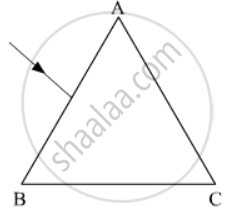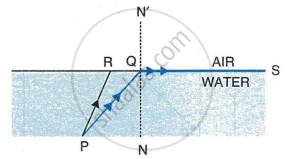Advertisements
Advertisements
प्रश्न
(i) Define critical angle.
(ii) State one important factor which affects the critical angle of a given medium.
उत्तर
(i) The angle of incidence for which the angle of refraction is 90o is called critical angle.
`"_1 mu _2 = (sin i_c)/(sin (90^circ))`
`therefore (mu_2)/(mu_1) = (sini_c)/(1)`
` therefore 1/mu = sini_c " If " mu_2 = 1 mu_1 = mu`
` therefore i_c = sin^(-1) (1/mu)`
(ii) Relative refractive of the medium `("_1 mu_2)`1
APPEARS IN
संबंधित प्रश्न
The figure shows a ray of light falling normally on the face AB of an equilateral glass prism having refractive index`3/2`, placed in water of refractive index `4/3`.Will this ray suffer total internal reflection on striking the face AC? Justify your answer.

In the given figure PQ and PR are the two light rays emerging from an object P. The ray PQ is refracted as QS.

- State the special name given to the angle of incidence ∠PQN of the ray PQ.
- What is the angle of refraction for the refracted ray QS?
- Name the phenomenon that occurs if the angle of incidence ∠PQN is increased.
- The ray PR suffers partial reflection and refraction on the water-air surface. Give reason.
- Draw in the diagram the refracted ray for the incident ray PR and hence show the position of image of the object P by the letter P’ when seen vertically from above.
Write the necessary conditions for the phenomenon of total internal reflection to
occur ?
Solve the previous problem if the paperweight is inverted at its place so that the spherical surface touches the paper.
How does a ray of light bend when it travels from rarer to denser medium
How are critical angles related to the refractive index of the medium?
Which of the following statements about total internal reflection is true?
Define the critical angle.
What are the examples of total internal reflection in nature?
The phenomena involved in the reflection of radiowaves by ionosphere is similar to ______.
